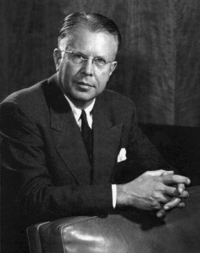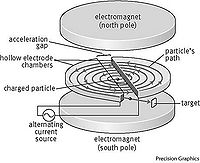Ernest Lawrence
Claimed by Thomas Corbett Kaniff

Personal Life
Ernest Orlando Lawrence was an American physicist born in Canton, South Dakota on August 8th, 1901. His parents, Carl Gustavus and Gunda Lawrence, were both the children of Norwegian Immigrants who met while teaching at the same high school. Ernest had one younger brother named John H. Lawrence who pioneered the field of nuclear medicine. In 1926 he met his wife Mary Kimberley (Molly) Blumer and the two eventually married in 1932. They went on to have six kids named Eric, Margaret, Mary, Robert, Barbara, and Susan. Ernest Lawrence died on August 27, 1958 due to an assortment of medical issues at Palo Alto Hospital in Palo Alto, California.
University Education
After attending high school at Canton High School, Lawrence attended many universities. He first attended St. Olaf College for a year before transferring to the University of South Dakota where he received his B.A. in Chemistry in 1922. In 1923 he received his M.A. in Physics from the University of Minnesota then went on to spend time at the University of Chicago before receiving his Ph.D. in Physics from Yale in 1925.
Career
After completing his education, Lawrence received multiple offers to be an assistant professor from the University of Washington and the University of California and Yale University. Lawrence elected to stay at Yale until 1928 when he was hired by the University of California as an associate professor and two years later became a full professor, becoming the schools youngest professor. Eight years later he was named the Director of Berkeley's Radiation Laboratory which he stayed until his death in 1958.
Scientific Contributions
Cyclotron

Ernest Lawrence is most famous for his invention of the cyclotron. For his work in nuclear physics, Lawrence needed a particle accelerator in his lab. The time periods standard model was a linear accelerator and to make more powerful experiments you would need much higher energy that would come from making the accelerator longer. However, his lab did not have room for an increasingly long accelerator so he began trying to make a more compact accelerator.

The idea for the cyclotron began when Lawrence read an article by Rolf Wideroe that had a model for an accelerator that was still linear, but had increasingly longer electrodes to increase the speed of the particle. He then applied this idea to a circular chamber. The cyclotron is two semicircle metal chambers called dees that are placed in a very strong magnetic field. Near the center of the cyclotron there is a source of slow protons and a slit in each dee. Inside the metal dees the electric field is zero, however when it exits one dee it receives a boost in energy from the potential difference between the two dees and increases speed. While the particle is in one of the dees, the electric field is reversed, this reversing the potential difference between the dees so that the particle receives another boost when it crosses the gap. This increase in speed causes the particle to take a path with a larger radius every time it enters a new dee. The particle continues this spiral pattern and continues to accelerate until it reaches the opening at the edge and shoots the proton at the nucleus of an atom.
Lawrence made many versions of the cyclotron at his time at Berkeley. The first one was 5 inches in diameter but the sizes grew to 11, 27, and 60 inched in diameter at his Berkeley lab. The largest modern circular accelerator is currently at CERN in Geneva, Switzerland and has a circumference of 17 miles. In 1939 Lawrence won the Nobel Prize in Physics for his invention of the cyclotron.
Manhattan Project
As one of the nation's most prominent American nuclear physicists, Ernest Lawrence became involved in many military projects that started due to the outbreak of World War II. Some of these included further developooing the cavity magnertron and also helping at underwater sound labs to develop technology to detect submarines. However, his most important work came in his contributions to the Manhattan Project. Lawrence and his colleagues used the 60inch cyclotron to create new isotopes of uranium and plutonium. Plutonium's discovery was kept secret until after the war was over because it turned out that the isotope plutonoum-239 could undergo nuclear fission and be used to make atomic bombs. Lawrence began separating these isotopes using a mass spectrometer which as a technique developed by Oliphant. He converted his 37inch cyclotron into a mass spectrometer and during the Manhattan Project, Lawrence's Radiation Laboratory was responsible for the development of the electromagnetic uranium enrichment process that was used in the atomic bombs made at the Los Alamos Laboratory in New Mexico. Lawrence was a major contributor to the development of the atomic bomb through the Manhattan Project. As a result of this, after the war in 1958, President Eisenhower asked Lawrence to travel to Geneva Switzerland to negotiate a partial nuclear test ban with the Soviet Union.
Awards
- Hughes Medal (1937)
- Elliott Cresson Medal (1937)
- Comstock Prize in Physics (1938)
- Nobel Prize in Physics (1939)
- Duddell Medal and Prize (1940)
- Holley Medal (1942)
- Medal for Merit (1946)
- Officer de la Legion d'Honneur (1948)
- William Procter Prize (1951)
- Faraday Medal (1952)
- Enrico Fermi Award (1957)
- Sylvanus Thayer Award (1958)
References
en.wikipedia.org/wiki/Ernest_Lawrence#Early_life
www.nobelprize.org/nobel_prizes/physics/laureates/1939/lawrence-bio.html
www2.lbl.gov/Science-Articles/Archive/early-years.html
upload.wikimedia.org/wikipedia/commons/b/be/27-inch_cyclotron.
www2.lbl.gov/images/PID/Lawrence.gif
static.sfdict.com/dictstatic/dictionary/graphics/ahsd/jpg/AScyclot.jpg